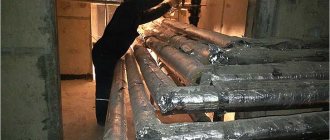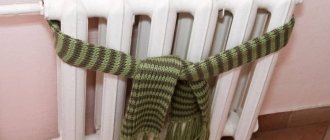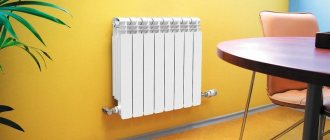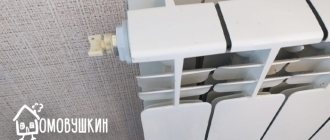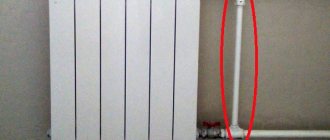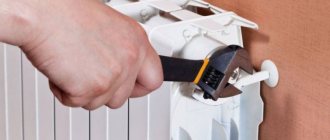A user under the nickname _maria502_ shared a pressing issue with Onliner.by readers. A girl living with her family in a ten-story panel building suffers every year from “overheating” - regardless of the temperature outside, the radiators in her apartment “fry” as in the most severe frosts. The owner of the property tried to combat the temperature chaos by contacting the housing and communal services department.
Every heating season, and especially at the beginning and end, when it is already relatively warm outside, overheating occurs in my apartment. But not quite overheating, but very unbearable heat, and this spring it even reached 30 degrees. Every time at such extreme temperatures, with great hope of salvation, I call ZhES-97 and ask for help: lower the temperature of the batteries. By the way, the batteries are in the walls.
Every time the housing department solemnly promises me a reduction. But they never do this just like that, on a simple request. For example, this spring, namely starting around March 14, it began to get warmer outside. Well, at home the batteries worked the same way as in sub-zero temperatures. I determined this by touching, or more precisely, by the inability to hold on to the battery with my hand due to the heat, both at sub-zero temperatures and at +10, and now at +18.
I called the Housing Office - to no avail. Knowing from the experience of previous overheats that they would wait until the heating was completely turned off, I began to contact the ZhREO of the Central District. There they professionally sent me to call various numbers from one specialist to another. That's what I did. In a week. Everyone promised to help me. As a result, the radiators were unbearably hot, and the air temperature outside the window warmed up to +18. ZhES sympathized and said that we do not have automation and need to manually adjust the valves. I say: what questions, is it realistic to adjust the valves? They say that probably yes. It is recommended to open windows.
By the way, all the residents above and below our apartment have their windows open - everyone regulates the heat in their apartments as best they can. ZhREO was generally pleased: they advised me to be patient. Everything can be understood and forgiven, but the nuance is that I have a small child who reacts sharply to drafts, which are inevitable when the windows are open, he instantly gets sick. You can take the child out of the room for a while and ventilate it, you say, but the problem is that with such a heat supply, as soon as you close the window - 1-2 minutes and again the greenhouse effect and the temperature on room thermometers is 27-28 degrees. You can't even open the window at night.
We are sweating profusely as we treat a child who has fallen ill due to these temperature controls: it is impossible to go outside. As a result, I come to the housing department, ask for a book of complaints, they ask me not to write, because they can punish the director, but he is so good. I understand that his employees feel sorry for him, but no one except me will feel sorry for him. I start writing and a good director appears. I emotionally tell him about my problem, he is dissatisfied with my story and thinks that I want to swear. Apparently, it does not suggest that I am trying to somehow defend my rights to a normal existence in the apartment. He says write whatever you want, I don’t want to talk to you.
The plumbers who were present begin to understand the tragedy of the situation and “take pity”: they go to the basement to adjust the valve. An hour after my hike, the bell rings and the plumber says: that’s it, I’ve done everything, just don’t complain if it gets cold now. I ask: did you turn off the heating completely? He says: what could I do? He says, I felt sorry for your child, so I pushed him away.
I would also like to touch on the material component. Nowadays they write a lot that the population pays only a small percentage for heating, the figures given are different. Everything else is paid by the state. This topic comes up regularly. So, I come to the question: why is ZhES, a state organization, not interested in saving public funds? An entire department for energy efficiency has been created, a lot of people are accepting applications to reduce heat energy consumption, in housing and communal services, in housing and communal services. But the plumber goes to turn down the heat only after he sees the person who complained, and then after he decides whether he feels sorry for his children or not?”
With the question of why ZhES-97 is not interested in the economical use of heat energy, we turned to the director of the institution.
- As practice shows, in such apartments it is not 30-31 degrees, but only 25 - because people do not ventilate the rooms, and they also install air humidifiers. So you come and check, but in the apartment neither the window nor the balcony ever opens. This morning, plumbers went to this apartment to turn off the heating supply. I just had to wait until Monday, as I explained to the hostess, when a qualified master, who was on leave, would come. The temperature in her apartment will decrease, but because of this the others will suffer, because there will be a lack of heat. The process is generally not labor-intensive: about an hour of work. There is no way to adjust the system - only reduce it. There is mechanical equipment in this house, it is not old, but it can only be adjusted manually,
— explained Vadim Solovey.
What do we usually complain about to city utilities when winter comes into its own? That's right, most of the complaints relate to heating. Often it becomes too cold in apartments, and we start asking utility companies to do something to make the radiators at least a little hotter.
But in the winter of 2016, many regions of Russia experienced a surprisingly warm winter. At times, the average temperature outside the window was ten degrees higher than normal. And utility services do not always have time to quickly respond to such changes.
As a result, many residents of Russia were faced with such a problem as “overtopping” for the first time. This word refers to a situation where heating network employees work too hard, resulting in the temperature inside apartments exceeding all established standards, causing discomfort among citizens. By the way, the normal temperature in an apartment is 22-24 degrees above zero on the Celsius scale. Fluctuations of plus or minus two degrees are considered acceptable. If the temperature does not meet these standards for quite a long time, you can make a fuss with a clear conscience.
The situation, to put it mildly, is atypical for Russia, and therefore few people know what can be done in such cases. And there can be several exits at once. Which one to choose will depend on the specific situation.
The simple way
The easiest way to cope with elevated room temperatures is for those who have a radiator system with regulated hot water supply installed in their apartment. It is enough to simply cover or completely shut off the water supply to the radiator, and the thermometer in your apartment will creep down before your eyes.
The balancing valve can also be installed on the heating riser. As a result of its complete or partial blocking, the temperature in the home will decrease. Having found the best option, you can easily bring your home climate to the required standard.
This will, of course, solve the problem of high temperature in your apartment. However, this is only suppressing symptoms when you can pay attention to the cause of the problem. There is another unpleasant aspect of overheating - every extra degree by which our radiators heat up is money that we overpay for heating.
Video description
Adjusting the heating in the apartment
Automatic regulator
The locking mechanism minimizes human intervention in the structure. The appropriate temperature will be maintained automatically. The user sets the required parameters only once, and the thermostat maintains the set microclimate.
A direct-acting locking mechanism is mounted at the battery inlet. The model is made in the form of a sealed cylinder, inside of which there is a reservoir with liquid (gas). The filler functions according to the laws of physics and reacts to changes in water temperature. When increased, the substance expands, puts pressure on the rod and blocks the flow of heat. When the degree decreases, the reverse procedure is carried out.
The high cost of components is the only drawback of the model. The more functions a device has, the higher the price. The parameters can be changed at any time, adapting to the needs of the occupants of the room.
Automatic device Source artmatica.ru
Electronic thermostat
Visually, the model resembles a control valve, but with a display. The desired room temperature is displayed on the screen. The mechanism works in tandem with a remote temperature sensor, which is embedded at the radiator inlet.
To create a favorable microclimate in the room, the base transmits the “task” to the electronic device. The regulator changes the temperature within 6-26 C. A special sensor monitors the maintenance of the settings.
“Smart” equipment for batteries Source termogolovka-ec.ru
We complain to all authorities
In order to avoid paying extra money for heating, it is necessary to draw the attention of utility companies to the problem of too hot radiators in the apartments of your building.
First, you should try to influence the situation through your management company. Formally, the residents of the building are not directly connected with the employees of the city heating network, therefore, it is not the apartment owners who should communicate with them, but the management of the management company, which is responsible for a particular building.
If a complaint is written to the management company, but it does not bring any results, you can contact higher authorities, which are the housing inspectorate and Rospotrebnadzor. It is important to draw the attention of officials to the fact that it is hot in the house, and contacting the management company did not lead to any results. It is not a fact that even such measures will be able to quickly solve the problem. Rather, it will have to be resolved due to natural conditions or a planned decrease in temperature in the network. But by doing this, you will show the management company that you do not intend to put up with their dishonest work, guaranteeing careful consideration of your future requests.
There is one nuance in this solution to the problem. It is important that you are not the only one who contacts the management company, and later higher authorities. You need to make sure that the other residents of your home also face the problem of overheating. After all, there are often cases when apartments on the first floors of a house are too hot, and residents of the upper floors complain about the cold, which forces utility workers to work harder. This is how it turns out.
In this case, simply adjusting the heating intensity will not solve the problem - the management company will be forced to carry out work to balance the heating system in the house so that the temperature in the apartments on the upper floors is the same as on the first floors of the house.
What to do with a stuck ball valve
When ball valves are not used for their intended purpose for a long time, they begin to jam due to the formation of scale. Do not use brute force to try to open the valve using a gas wrench or pliers. When the faucet handle does not unscrew immediately, then:
- You need to unscrew the fixing nut and remove the “butterfly” from the rod.
- Under the “butterfly” there is a nut that secures the plastic seal, which needs to be loosened. A key is used and the tap is turned half a turn.
- It is also possible to use a tool that allows you to firmly grasp the stem. It is possible to use an adjustable wrench. The rod turns without excessive effort.
- If resistance is felt, you need to move in the opposite direction, gradually increasing the amplitude by 5 degrees.
- It is necessary to develop the rotation of the rod until a right angle is formed. If this result is achieved, the gland nut is returned and the butterfly handle is installed.
Important! When you have WD-40 lubricant in the house, apply it to the soured rod and leave for 10 minutes. This makes it easier to unscrew.
Of course, an electric sheet is the result of technological progress, but hot water in a rubber heating pad or a simple plastic bottle was, is and will be one of the simplest and most effective means for heating a bed or body. It’s not for nothing that servants put copper hot water bottles in their masters’ beds several centuries ago. And now the rules of the game have not changed: put a heating pad in your bed before going to bed - and enjoy the warmth.
It is worth noting that there are special heating pads on sale that can be placed in the microwave. Heat it for one minute and you are ready to use. In addition, there is a salt heating pad: it heats up due to the crystallization of salt. The temperature of such a heating pad reaches 52 degrees Celsius.
Extreme measures
But it often happens that there are no control valves either on the risers or on the radiators in the apartment, and it’s too hot to wait for the actions of the management company and answers from the housing inspections and Rospotrebnadzor.
In such cases, you will have to use “folk” methods. The most popular way to regulate the temperature in an apartment is by opening the windows. You can try to find the optimal solution using this move. This will be much easier to do if you have modern plastic windows with micro-ventilation installed in your home. Such windows leave only a small gap through which cool, fresh air enters the apartment. This will prevent the apartment from cooling down and the temperature dropping too much.
There is another case - blankets. It is believed that by covering radiators with blankets, you can lower the average temperature in your apartment. The logic is simple: the material from which the blanket is made has a minimum heat transfer coefficient. It will receive heat from the radiator without “giving it away” to the atmosphere in the apartment. The solution, to put it mildly, is not the most reliable, but, as they say, in the absence of fish...
One of the most effective ways to combat the summer heat is air conditioning. It is able to cool the air in the room and maintain the desired temperature.
Of course, this method has disadvantages - the air conditioner requires complex and expensive installation. However, you can purchase a mobile air conditioner that does not require installation.
When it is not possible to purchase and install an air conditioner, you can use another device - a fan. With its help, the hot season is much easier to bear.
If the apartment windows face opposite sides of the house, you can open them and create a draft. But you need to remember that staying in a draft for a long time can be dangerous to your health.
It is necessary to limit the penetration of sunlight into the room. If curtains or blinds are not effective enough, you can use a mirror reflective film and attach it to the window. It will reflect infrared and ultraviolet rays. This film is especially effective if your windows face the sunny side.
The heat in the apartment is more difficult to bear if the air in the room is dry. It needs to be moisturized. To do this, you can use wet towels or sheets and hang them in the rooms. In addition, you can find humidifiers in stores that will maintain humidity automatically.
A constant flow of fresh air will help you endure the heat more easily. Of course, open windows partially help in solving this issue. But there is a more effective and technologically advanced way - to install fresh air ventilation valves. They will ensure proper air exchange around the clock.
Most common mistakes
The procedure will end in failure if some mistakes are made. The most common:
- Incorrect selection of material. To choose the right sound insulator, you need to consider the purpose and location. So, for example, glass wool is purchased for sewer insulation, and for residential use, sealant tape for joints is purchased.
- Lack of static in the heating structure. Sooner or later, a non-static system begins to wobble, “rattling.”
- Incorrect installation of sleeves, lack of gasket between sleeve and pipe, or missing sleeve.
The comfort and coziness of a home is formed from many factors; properly carried out sound insulation is only a small but significant contribution to the overall cause. A modern range of construction products and services will help silence the heating in every home, leaving only heat.
What to do if your apartment is hot in winter
In winter, some houses have very hot radiators. The air conditioner is powerless in winter - the external unit must operate at positive temperatures. But it can help in early spring, when it’s already around zero outside and the radiators are still hot.
The most effective way to deal with excessively hot batteries is to install thermostats or ordinary shut-off valves on them. With their help you can regulate the water supply. As a last resort, just block it.
If this is not possible, you can open the windows. But in winter this is fraught with the danger of catching a cold. If you open the windows for a short time, then after a while the air in the room will warm up again and the heat will return.
Heating radiators can be covered with damp towels or sheets. This will humidify the air and reduce the temperature of the batteries. There is only one drawback - the sheets dry out quickly and need to be constantly moistened.
Another option is to cover the battery with a thick blanket. It will serve as a heat insulator and help reduce the temperature. And next to the battery you can place a jar of water, which will evaporate and reduce the dryness of the air.
The management company is responsible for regulating the temperature of the water supplied to your home. You can contact it with a request to reduce the temperature of the coolant. If your request is ignored, you can file a written complaint with Rospotrebnadzor.
The weather never ceases to amaze and present surprises. Frosts are replaced by thaws and, conversely, thaws are replaced by frosts. Likewise, central heating (CH) never ceases to amaze. When it's cold - radiators
barely warm. When the temperature outside is above zero, they heat up so much that you can fry eggs on them.
Batteries get very hot
Coolants (hot water) are supplied to houses from the central heating point (central heating point). One central heating station can provide heat to up to a dozen houses or more. The coolant temperature is automatically regulated by special sensors, which increase or decrease it depending on the outside air temperature. Very often the automation does not work and all adjustments must be made manually.
So, if in an apartment you have to keep the windows open all the time, then most likely these sensors are not adjusted or are not working. What to do? Call your ODS and ask to call a specialist from OJSC MOEK, only when talking with the dispatcher, state in detail the very essence of your request.
The dispatcher is not interested in such details as how and in what form, you walk around the apartment or what you are sweating. He is only interested in specific facts. That's all!
It may, and most likely, happen that everything will remain unchanged. The thing is that the organization OJSC MOEK adjusts its equipment only when there is a mass appeal from residents, and does not pay attention to isolated cases.
But all's well that ends well. The temperature of your batteries dropped and you breathed a sigh of relief. But don't be fooled. Everything can return to normal. What is good and comfortable for you will not necessarily be good and comfortable for others. And once again, having touched your heating radiator, you, burned, withdraw your hand. Don't rush to curse. It so happens that another tenant or tenants in your house complained about weak heating. It should be noted that the temperature in the apartment should not be lower than + 18 0 C. In this case, there is nothing left to do but increase the temperature of the coolant to the original one.
This can go on for a long time. Some will complain that they are hot, others that they are cold. The thing is that it is impossible to regulate the temperature of the central heating radiators in a separate apartment because its heating system is built into the general heating system of the house. This can only be achieved by installing modern heating radiators with temperature controllers. True, there are two more ways - to wait until frosty weather sets in outside and the temperature in the apartments becomes comfortable for everyone, or to force OJSC MOEK to monitor its equipment more carefully.
The question of how to protect a battery in an apartment from excessive heat is often found on the Internet. Various thematic and simply everyday forums are replete with this kind of messages, giving homeowners valuable practical advice. You can refer to some of them.
How to cover the battery from the heat?
Heat-reflecting screen behind the radiator: to install or not?
What is a heat reflective screen
The heat-reflecting screen increases the efficiency of the heating system.
Does not require complicated installation and costs pennies.
The structure becomes a barrier between the heat source and the surface of the external wall.
The room temperature rises by 2-3 degrees.
Energy consumption is reduced by 5-7%.
Where does the heat go?
Heating devices in buildings are installed under the windows.
The goal is to warm the air inside and create a thermal curtain that prevents the penetration of cold from the street.
Heat spreads from a heated object to a cold one.
The wall temperature is lower than that of the radiator.
In the cold season, the surface behind it heats up to 35-40 °C.
Instead of heating the air inside a warehouse or office, some of the energy is used to heat the external walls.
Heat-reflective polyethylene foam screen
Substances have different abilities to conduct heat.
To prevent energy consumption, the heat-reflecting screen must have low thermal conductivity - no higher than 0.05 W/(m*K).
Heat-reflective polyethylene foam screen
It is not recommended to use structures made of flammable substances with a loose structure indoors.
For example, mineral wool, which releases formaldehyde and microscopic dust, is not suitable for the screen.
Although its thermal conductivity coefficient is suitable - 0.039 W/(m*K).
Heat-reflecting screens made of insulating materials based on polyethylene foam have proven themselves to be the best:
- penofol,
- Porilexa,
- isolona,
- stizol,
- tepofol.
They are hypoallergenic and safe for human health.
The thermal conductivity of different types of polyethylene foam ranges from 0.029 to 0.032 W/(m*K).
Four millimeters of such a barrier will retain as much heat as 10 centimeters of mineral wool.
For insulation between the wall and the heating device, a layer of 3-5 millimeters is enough.
Mandatory condition: the heat-insulating screen behind the radiator must be duplicated with aluminum.
Why do you need foil?
The coefficient of reflection of thermal radiation of polished aluminum is higher than that of other metals.
This means that maximum heat will return inside the room.
You should not use screens with a double-sided metal backing.
The layer of foil on the side of the cold wall does not carry a functional load - it simply has nothing to reflect.
Unscrupulous sellers in construction markets deceive customers by talking about new metallized coatings with fantastic characteristics.
These are fairy tales.
Any polished metal refracts heat rays, but the reflection coefficient is negligible and does not affect thermal efficiency.
The cost per square meter of a thermal reflective screen with aluminum foil is more expensive than with a metallized film.
The difference is small - 5-10 rubles.
Pros of a heat reflective screen
Pros of a heat reflective screen
The heat-reflecting screen behind the radiator solves two issues:
- increases heat transfer - the main goal,
- reduces heat loss.
All this at minimal cost.
Areas behind heating appliances get hotter than others.
Being an additional insulation, the screen restores their thermal conductivity along with the rest of the wall.
The idea is not new.
It has been tested in practice many times and discussed in specialized literature.
The effectiveness of heat-reflecting screens is indicated by
In their opinion, a heat-reflecting screen behind the radiator can reduce the heat loss of a 0.51-meter thick brick wall by 35%.
Disadvantages of a heat-reflecting screen
Disadvantages of a heat-reflecting screen
The area behind the radiator is no more than 5% of the entire area of the external wall of the room.
The main heat losses occur through infiltration and windows.
Against this background, the improvement in heat transfer over an area of half a meter is negligible.
But if you add up the reduction in heat loss throughout the entire building, the amount of savings will be significant.
For uninsulated walls with low thermal resistance, a heat-reflecting screen is useless.
Heat losses are so large that improving heat transfer in an area of 0.5 sq.m. It won't even be noticeable.
If the radiator is in a niche
In buildings where heating devices are located in niches, heat loss is higher.
The walls behind the radiators are thinner and colder than the others.
Heat is transferred not to one, but to three low-temperature surfaces at once.
Therefore, if space allows, it is worth increasing the thickness of the insulation to 10-15 millimeters.
In addition to the material, it is important how the heat-reflecting screen is attached to the radiator.
Illiterate installation will negate the entire expected effect.
Installation of heat-reflecting screens
Installation recommendations
The screen is mounted on the wall behind the heating device.
The reflective layer turns towards the heat source.
It is important not to allow the radiator and foil to come into contact so as not to interfere with heat transfer.
Russian manufacturers consider a gap between them of 1-2 centimeters sufficient, foreign manufacturers – no less than 4-6.
The air gap is part of the thermal insulation barrier.
The thermal conductivity of air depends on temperature and ranges from 0.0259 to 0.0915 W/(m*K).
There is no point in installing a heat-reflecting screen behind the radiator if it is mounted close to the wall. Insulation pressed end to end will actively collect dust, but will not affect convection in any way.
Ideally, a gap between the wall and the heating system should be provided at the design stage.
Then you will have room to maneuver.
Recommendations for installing thermally reflective screens
What not to do
Place the unit too low.
If the distance between the floor and the bottom of the radiator is less than 10 centimeters, heat transfer efficiency decreases and cleaning becomes more difficult.
Do not lift the device too high.
When the gap between the floor and the radiator is more than 15 centimeters, the air temperature gradient increases relative to the height of the room, especially in the lower part.
Do not install the device close to the wall.
The distance between the top of the radiator and the window sill is at least 15 centimeters. Anything less degrades heat flow.
Installation stages
The most reasonable thing is to provide for the installation of a heat-reflecting screen at the construction stage - after rough finishing, before installing the heating.
If the repair is completed and the radiator is in place, you will have to remove it.
The size of the screen must correspond to the working surface of the heating device.
Then it will be invisible and will not spoil the interior.
In production areas where aesthetics are not important, it is worth increasing the area by 10 percent to ensure maximum reflective effect.
The wall under the window is cleaned of dirt and crumbling plaster, defects are puttied, irregularities are removed with sandpaper.
You can start installation.
If there is enough space, a more reliable option is a lattice base made of thin wooden slats.
Additionally, we obtain a layer of air between the wall and the thermal insulation sheet.
It will have a positive effect on heat transfer.
The radiator returns to its place.
It is important to adjust the position of the device so that a distance of one and a half centimeters (minimum) is maintained between the foil covering and the back side.
If possible, make the gap larger.
The heat-reflecting screen does not require special care.
It is enough to wipe the dust on it sometimes.
If the aluminum layer is scratched or torn, metallized tape will help remove the damage.
Functionality will not be affected by this.
Other types of screens
Often the heat-reflecting screen behind the radiator looks like a plywood shield covered with aluminum.
It also works, but the efficiency is lower than that of a polyethylene structure.
Sometimes foil without a foam insulation backing is used as a damper between the wall and the heating appliance.
We believe that there is no point in this, since although the aluminum sheet reflects up to 90% of thermal radiation, it itself quickly heats up (too thin) and transfers heat to the wall.
You may be interested in:
How to cover the radiator to prevent it from being hot in the apartment - Clean House
17.12.2019
- The owner of a private house with an autonomous heating system has the opportunity to turn off the boiler at any time, depending on the weather outside or based on other considerations.
- To shut off the heating device, ball valves are required
- For those who live in houses with central heating, questions about how to turn off the radiator usually arise in two cases:
- if the weather is warm outside and the central heating has not yet been turned off, since the heating season has not officially ended;
- if necessary, replace, repair or paint the radiator, repair the wall behind the radiator.
In this case, one should take into account this point: there is always a coolant inside the battery. It is drained only in case of repair work in the system. This is due to the fact that the main part of the heating devices installed in old houses, as well as the intra-house wiring, are made of steel.
The simplest way
Widely used in standard apartments, cast iron radiators are the best way to heat residential premises. However, such heating devices also have their drawbacks, mainly associated with the lack of a thermostat and an excessively high output of accumulated energy. You can consider ways to optimize the operation of cast iron radiators, if any are present in your apartment.
The simplest and most effective material for eliminating excessive heat transfer from a cast iron battery is a regular blanket placed on the planes of the radiator. Closing the battery with it will be a matter of seconds for you. The possible predicted skepticism of many Internet users is associated, first of all, with poor knowledge of the physical processes described in the school curriculum.
Reduced indoor humidity will be a minor side effect. It can be easily eliminated by purchasing an air humidifier (its average consumption in a typical apartment is up to three liters of water per day) and a psychrometer - a device that controls the level of humidity in the room.
Do not use the windows as a way to lower the room temperature; they can only be opened for natural ventilation of the room. Otherwise, the presence of very dry air in the apartment can lead to unpleasant consequences for the nasopharynx and skin. The heat escaping from the room will not significantly reduce the heating temperature.
The rationale for such advice lies in the physical processes that occur when cold street air enters the apartment. This air, which has a low level of humidity, heats up as it passes through the window into the room and reduces the absolute value of humidity. Accordingly, an increase in the humidity of the apartment atmosphere will occur with the help of your breath and skin, taking away the water it needs from the body.
Bed
The optimal temperature for sleeping is 16 degrees, at which people feel rested and healthy. In addition, the room must have humidified air. Placing the bed next to heating appliances makes it difficult for people to get quality sleep.
The air around the batteries is very hot and dry. If you inhale it all night, in the morning a person wakes up lethargic, tired and as if sick. Doctors say that sleeping in such conditions provokes frequent relapses of colds and other diseases. Due to dry air, breathing difficulties and peeling of the skin occur.
Alternative methods
One of the alternative ways to protect against excessive heat in a living space is to purchase and install a special valve. Such a simple device allows you to regulate the level of thermal energy supplied to the battery and save its value in ruble equivalent. The principle of saving becomes important for apartment owners, since heat distribution will be possible depending on atmospheric conditions.
The current state of the market for plumbing fixtures and fittings makes it possible to purchase a special protective screen that operates on the principle of blinds. One turn of the flaps of such a screen helps to reduce the amount of thermal energy distributed throughout the apartment, as well as minimize the risk of burns from an excessively hot radiator. Another advantage of placing a louvered screen is the simplicity of its design, which allows you to avoid complex installation work. Installing this type of device will not take more than 10 minutes of your time.
The most radical way to limit the heat supply to your apartment is to contact the office of the management company. Such treatment will reduce the thermal effect from the apartment radiator by covering the corresponding common house valve. This method is not a panacea if limiting the heat supply to the apartment is necessary exclusively for you. Using this option will also affect your housemates who may not be feeling hot.
Technical rules
One of the requirements is the accessibility of the radiator. It may leak and will have to be replaced or repaired. Therefore, it is better to choose designs that are easily removable. It is advisable that they do not have a fixed mount. Overlays with a folding door and a retractable mechanism are suitable. At a minimum, valves, pipe connections, thermal head and threaded connections should remain accessible in case of breakdown.
The second important point is related to the amount of heat entering the house. Any box reduces it. Especially if it is deaf, completely closed at the top or has a tight weave. It is better to choose something more open and not place the heater too deep. To reduce heat loss, you can put a solid screen on the legs and cut a groove in the middle.
Using a Heat Shield
The heat from the hot battery is transferred in different directions and directions, creating a comfortable environment in the apartment. The use of a special heat shield will not only effectively reduce the excessive temperature of the battery, but also avoid heat leakage, reaching up to 20 percent. A battery placed in a niche releases heat not only into the apartment, but also onto the external wall, actually heating the street.
The heat shield can be installed using a special heat-insulating material placed between the wall and the heating radiator.
This “life hack” will give the heating system several extremely positive qualities:
- providing thermal insulation of walls;
- prevention of excessive heat transfer resulting from differences in street and room temperatures;
- ensuring an effect in which heat from the heating device is reflected into the depths of the room;
- achieving uniform distribution of heat transfer, protection against battery overheating.
Various thermal insulation materials used to create screens have a foil base. A special combination of materials such as polystyrene foam or polyethylene foam with foil can shield thermal energy through good thermal insulation properties. The foil present in this device reflects about 90 percent of the heat, eliminates its loss and helps it to be evenly distributed throughout the room.
Niches for heating radiators: design, finishing and decoration
Combination of functionality and beauty Batteries are an important element of heating of any buildings. The principle of their operation is simple. They heat the air that circulates in the rooms. In general, a necessary and completely understandable function for each of us. Old heating devices sometimes do not decorate our interior. They sometimes even irritate with their unpresentable appearance. In addition, they take up a lot of useful space in a small room. I just want to hide the radiators somewhere. This is understandable, times have changed. Today, many customers expect more than just flawless performance from modern heating systems. And also aesthetic appeal. Moreover, new materials, technologies and approaches make it possible to achieve this.
How to cover radiators You can paint them in a suitable color. Cover with wallpaper or special stickers. However, this does not completely solve the problem. Designers recommend installing decorative metal, wooden and plastic grilles. This is also a good option. We propose the most radical approach: install the radiator in a niche. It is clear that such work can only be carried out by specialists who have special professional skills.
How to close the battery in a niche? A recessed space in the wall for heating equipment can be created both under window openings and in other convenient places. In this case, the installation of niches for radiators in external walls must comply with certain requirements. And further. In order for room heating to continue to be effective, there must be a constant flow of air to the devices. It should be remembered that by creating a niche for the radiator and covering it with a grille, you cannot completely isolate it. The width of the recess should be 30 cm greater than the width of the radiator. This additional space is necessary for the installation of shut-off and control valves. The depth of the niche for the battery can be 20-25 cm. Its size depends entirely on the model of the device. Since the thickness of the outer wall becomes noticeably smaller, the wall should be well insulated.
Niches for a plasterboard battery After laying the insulation, they begin to install a metal frame made of profiles. This structure is reliably sheathed with plasterboard. The insulation layer together with plasterboard should not exceed 10 cm. Then paint or wallpaper. The installation of heating radiators in a niche itself is no different from the usual installation of heating equipment. After installing the radiators, the entire structure is covered with decorative grilles of various types for aesthetic appeal. They are installed flush with the wall. This approach to the arrangement of the heating system makes our housing modern and comfortable. Allows you to significantly save room space.
You can get advice from our specialists in Orel by calling: 8-903-637-0410, 8 (4862) 780-410
Heat Shield Materials
Foil foam is usually found in retail sales as short rolls. The thickness of the material layer in this case is up to 3 millimeters, and for foamed polyethylene – up to 4 millimeters. The thermal insulation properties of these materials are comparable to the properties of a 100 mm layer of mineral wool insulation.
When placing a screen that reflects heat, one can and should take into account such an important factor as the minimum distance between the edge of the radiator section of the battery and the inner wall, which is 4 mm. If you change this distance downward, it will complicate or disrupt the circulation of warm air and, as a result, convective heat transfer and the efficiency of the radiator.
Special cases of placing a heating battery on the wall do not allow the installation of a full-fledged screen that reflects heat. The way out of this situation is to mount aluminum foil on the wall, its shiny surface copes well with heat reflection. One sheet of such material, placed on a standard brick wall (if its thickness is 51 centimeters), will reduce the heat transfer loss of the battery by up to 35 percent.
The various methods discussed above for eliminating excess thermal energy from a battery can be taken into account as effective methods that have been proven in practice. If it gets too hot in the apartment, use what is said to make your home as comfortable as possible.
Types of sound insulators
For sound insulation purposes, many materials have been developed that can be used in various fields. The most popular of them:
Made from fiberglass. This material is characterized by elasticity, strength and vibration resistance.
The principle of sound absorption in this material is simple - many voids between the fibers are filled with air, which is why the sound wave is not reflected and does not return. Glass wool is actively used to create partitions and cover parts of heating systems located on the streets. The advantages are fire safety, vapor permeability and chemical passivity (no corrosion occurs upon contact with metals), as well as low weight and cost.
- Mineral wool
Under what conditions can you place a refrigerator next to a radiator?
The instructions say that you cannot place the refrigeration unit near the radiator if the distance between them is less than 35 cm. But for small kitchens this is an unaffordable luxury. Therefore, if it is necessary to move the unit closer to the battery, it is necessary to isolate it from heat. To do this, you need to make a partition the size of the refrigerator from plywood, plastic or plasterboard and cover it with aluminum foil. Then place a protective shield between the unit and the heating radiator with foil to the battery so that it reflects thermal radiation.
If possible, you should place the refrigerator so that it covers the battery with only half of the body, or better yet, even less. It is also necessary to leave a gap of 5 cm on the other side of the case between the side wall and the furniture, which is necessary for the circulation of cooling air.
Typical questions
How to insulate a heating radiator so that it does not overheat?
To reduce the level of heating of the room from a radiator without adjustment devices, you should use thermal insulation materials. First you need to prevent air circulation near the heated surfaces of the heating radiators. For this purpose, you can use ordinary foil and wrap it around the radiator. A layer of heat-insulating material must be laid on top of the foil covering.
In residential premises, you should not use materials such as asbestos fabric and asbestos sheets, mineral wool and fiberglass, as they emit toxic substances into the air that can be harmful to health.
For thermal insulation, it is advisable to use woolen fabric with good heat resistance.
Which thermostats are better?
You should choose a thermostat taking into account the type of heating system, personal preferences and the allocated budget.
How does a thermostat work?
To improve the microclimate in your home, it is necessary to reduce the volume of coolant that passes through the equipment. Heat adjustment in radiators is carried out by turning the valve element or by changing the characteristics of an automatic device.
At the same time, the volume of hot water that passes through the compartments and pipeline decreases, as a result of which the radiator warms up with less intensity.
The heated water, once in the heating equipment, heats the metal alloy, which releases thermal energy into the surrounding space. At the same time, the level of heating of the room depends both on the amount of liquid inside and on what metal the equipment is made of.
Cast iron is heavy and releases heat energy slowly. Therefore, temperature sensors and special regulators are often installed on batteries made of this material, because the device will cool for a long time. Copper, steel and aluminum alloys heat up and cool down more quickly.
Installation of heating radiators must be carried out before the heating season, since during this period there is no coolant in the system.
In multi-apartment buildings there is no possibility to change the temperature of the coolant in the radiators. However, in this case, you can install a radiator thermostat, which makes it possible to influence the microclimate in the home in a different way. However, this solution cannot be implemented if the liquid moves from top to bottom. Owners of private houses have the opportunity to individually configure the operating characteristics of the heating system. Therefore, in such a situation, installing regulators becomes advisable.
